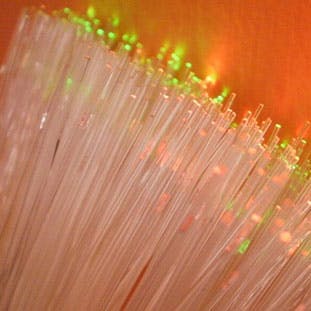
They may not realize it, but starting today, some high-end Internet subscribers in Chattanooga, Tenn., will turn on their computers and start browsing the Web at a gigabit per second — 10 times the speeds they're used to. By month's end, some 39,000 area residents will see their mid-tier connections become twice as fast — from a current 50 megabits per second to 100. Better yet, the majority of these customers won't pay a penny for the upgrade.
For that, city residents have an unlikely business to thank: the publicly owned electric utility.
High-speed fiberoptic networks — which work by sending data as instant pulses of light rather than signals over a metal cable — are generally thought of as a telecom product. Google has also gotten into the game, switching on next-generation broadband in Kansas City, Kan. But in places where neither is readily accessible, municipal governments have taken it upon themselves to build their own versions of Google Fiber.
It's a model that's proven successful for Chattanooga. There, the effort to bring cheap broadband to the masses began as a simple engineering problem: The city's electric company, EPB, needed a way for its systems to monitor and communicate with new digital equipment being installed on the grid. Meanwhile, city hall was learning that the country's biggest phone and cable companies wouldn't be starting service there for a decade or more.
So EPB became an ISP. Now it operates some 8,000 miles of fiber for 56,000 commercial and residential Internet customers. With today's rollout, gigabit service will cost $70 a month, down from $300 a month just last year. The system has gotten consistently strong ratings on DSLReports, the Internet's venerable hub for comparing broadband services.
"What that gives us today is the ability to put 10 gigabits per second in any home or business in our service territory," says Harold DePriest, EPB's CEO. "That could be a manufacturer or office building, or it could be a trailer in a small lot on the back side of Soddy Mountain."
Municipal fiber networks are relatively rare. Just 2,000 cities even have public electric utilities, according to Christopher Mitchell, a public broadband advocate at the Minneapolis-based Institute for Local Self-Reliance. Of those, 400 have any kind of broadband network — and only 150 have fiberoptic networks that span the entire jurisdiction.
DePriest tells me that EPB's fiber network is "a great profit center." In the four years the service has been active, the utility company has increased its mid-tier speeds three times — from 15 Mbps to 30 Mbps, from 30 Mbps to 50 Mbps and now from 50 Mbps to 100 Mbps. About 2,500 elite users will enjoy 1-gig speeds by the beginning of October.
EPB's most important fiber customer, however, is EPB. The power company has hooked up its fiberoptic network to the local smart grid, which involves 170,000 intelligent electric meters all reporting back to the company via Internet every 15 minutes. The grid also includes 1,200 switches that can route energy around the grid at a moment's notice.
Those capabilities become crucial in the midst of a storm, says DePriest. The switches allow the company to send power around a damaged area, keeping most customers' homes lit rather than having entire swaths of the city go down because of a few downed lines. What's more, the smart meters can tell EPB exactly where a problem area is, which means DePriest doesn't need to send crews out as often on speculative trips.
"I typically budget $2 million a year in overtime," says DePriest. "Now we feel we can save a million a year."
Are those savings worth it? For a lot of cities, says Brian Dietz of the National Cable & Telecommunications Association, the math doesn't really work out — which explains why muni-fiber isn't more common. Even if the big telcos lack a presence, some cities are already served by smaller cable companies that work just fine for most people.
Cities have to go to enormous lengths to execute the fiber build-out. Chattanooga spent $330 million on its new network, raising $220 million in bond money and winning $111.5 million in federal stimulus dollars. (The money from Washington was like icing on the cake; by the time EPB applied, it had already reached its initial targets and with the additional funds cut a 10-year construction plan down to three years.) Along the way, EPB fought several court battles with Comcast and the state cable association. Even before all this, Chattanooga had to lobby the state government for permission to let EPB participate in the telecom market.
"There's 19 states that make it harder for local governments to do this," says Mitchell. "There are hurdles to doing this that make it either very difficult or impossible to build these local networks."
In other regions such as Longmont, Colo., incumbent cable companies view muni-fiber as a threat and have spent hundreds of thousands of dollars contesting the service on city ballot measures.
To understand why cable companies are so resistant, it helps to understand a bit about their business model. Because dense urban areas are more profitable than sparsely populated rural areas, cable firms subsidize the greater costs of rural service with revenues from cities, says the Competitive Enterprise Institute's Fred Campbell. Take away the cable companies' urban revenue, and they might not be able to fund the rural service any longer.
If they don't exit the more costly markets, the large cable companies might cede some territory to those smaller companies, whose operations are partly subsidized by fees that appear on all of our telecom bills. Some of those fees go into the Universal Service Fund, which the Federal Communications Commission has used as a way to expand broadband access across the country.
Campbell and Dietz agree that in places where traditional cable doesn't exist, cities might have good reason to start their own fiber project. And in fact, communities that have built fiber networks themselves are sometimes resentful about it, mostly because it means they were overlooked by the big service providers.
"This isn't something that most local governments really want to do," says ILSR's Mitchell. "Chattanooga is one of the few. Most local governments have built these local networks because they felt they had to ... to stay economically strong."

We welcome journalists to contact the Media Relations team for information and news about EPB:
Follow @EPB_Chattanooga for the latest company news
We’re available anytime to provide customer service and technical support.
Click to gain access to the EPB Brand Central asset library.